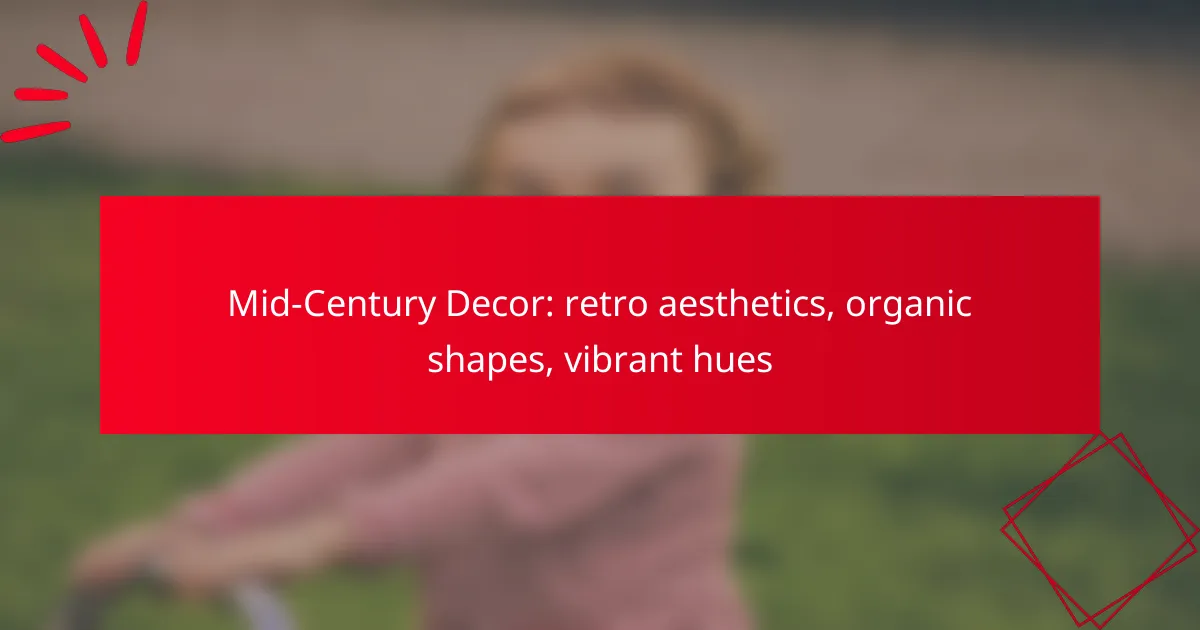Mid-Century Decor: retro aesthetics, organic shapes, vibrant hues
Mid-Century decor is a celebration of retro aesthetics characterized by organic shapes, vibrant hues, and functional designs. Emerging in the mid-20th century, this style emphasizes clean lines and artistic expression, creating a stylish and inviting atmosphere in any home. By incorporating thoughtfully selected furniture and accessories, you can effortlessly embrace the charm of this iconic design movement.

How to incorporate Mid-Century Decor in your home?
Incorporating Mid-Century decor into your home involves embracing its distinctive elements such as organic shapes, vibrant colors, and functional designs. By thoughtfully selecting furniture and accessories that reflect these characteristics, you can create a stylish and inviting atmosphere.
Use organic shapes in furniture
Organic shapes are a hallmark of Mid-Century decor, emphasizing fluid lines and natural forms. Look for furniture pieces like rounded sofas, sculptural chairs, and oval coffee tables that embody these characteristics.
When selecting furniture, consider options made from wood, fiberglass, or molded plastic, as these materials often feature the soft curves typical of this style. Avoid overly angular or rigid designs, as they can clash with the organic aesthetic.
Choose vibrant color palettes
Vibrant color palettes are essential in Mid-Century decor, often featuring bold hues like mustard yellow, teal, and avocado green. These colors can be used on walls, furniture, or accessories to create a lively and energetic space.
To effectively incorporate these colors, consider using them as accent pieces, such as throw pillows or artwork, while keeping larger items in more neutral tones. This approach allows you to maintain balance while still embracing the vibrancy of the Mid-Century aesthetic.
Incorporate retro accessories
Retro accessories play a crucial role in enhancing the Mid-Century vibe of your home. Look for items like vintage lamps, geometric patterns, and classic ceramics that reflect the era’s design principles.
Consider visiting thrift stores or online marketplaces for authentic pieces that add character and history to your decor. Be mindful to choose accessories that complement your existing furniture without overwhelming the space.
Mix with modern elements
Mixing Mid-Century decor with modern elements can create a balanced and dynamic interior. Pairing sleek, contemporary pieces with vintage furniture can highlight the unique features of both styles.
For instance, a modern coffee table can contrast beautifully with a Mid-Century sofa, while contemporary art can provide a fresh focal point against retro furnishings. Aim for a cohesive look by maintaining a consistent color scheme or material palette throughout the space.
Focus on functional design
Functional design is a key principle of Mid-Century decor, emphasizing practicality without sacrificing style. Choose furniture that serves multiple purposes, such as a storage ottoman or a dining table that doubles as a workspace.
When selecting items, prioritize quality and craftsmanship, as well-made pieces will stand the test of time. Avoid clutter by ensuring that every item in your space has a purpose, contributing to both aesthetics and functionality.

What are the key characteristics of Mid-Century Decor?
Mid-Century Decor is defined by its focus on clean lines, organic shapes, and vibrant colors. This design style emerged in the mid-20th century and emphasizes functionality while celebrating artistic expression through simplicity and natural elements.
Emphasis on simplicity
Mid-Century Decor prioritizes simplicity in both form and function. Furniture and decor pieces often feature minimal ornamentation, allowing the beauty of the materials and craftsmanship to shine. This approach creates a serene and uncluttered environment, which is ideal for modern living.
To achieve this aesthetic, choose furniture with sleek silhouettes and avoid overly complicated designs. Look for pieces that serve a purpose without unnecessary embellishments, such as a simple wooden coffee table or a streamlined sofa.
Use of natural materials
Natural materials play a crucial role in Mid-Century Decor, contributing to its organic feel. Commonly used materials include wood, leather, and stone, which add warmth and texture to spaces. These elements not only enhance the visual appeal but also promote sustainability.
When selecting furniture or decor, opt for items made from solid woods like teak or walnut, and consider incorporating textiles like cotton or linen for upholstery. This choice not only aligns with the aesthetic but also ensures durability and timelessness.
Bold geometric patterns
Bold geometric patterns are a hallmark of Mid-Century Decor, often seen in textiles, wallpapers, and artwork. These patterns can range from simple shapes to more intricate designs, adding visual interest and a sense of playfulness to a room.
To incorporate geometric patterns effectively, use them as accent pieces, such as throw pillows or area rugs, to avoid overwhelming the space. Pair these patterns with solid colors to create balance and maintain the overall simplicity characteristic of the style.

Where to find Mid-Century Decor items in the UK?
In the UK, you can find Mid-Century decor items through various channels, including online retailers, specialty stores, and antique shops. Each option offers unique selections that cater to different tastes and budgets.
Online retailers like Wayfair
Online retailers such as Wayfair provide a vast array of Mid-Century decor items, ranging from furniture to decorative accessories. Shopping online allows you to compare prices easily and access customer reviews, which can guide your purchasing decisions.
Look for sales and discounts, especially during seasonal events, to get the best deals. Make sure to check the return policy before purchasing, as online shopping can sometimes lead to discrepancies in product expectations.
Specialty stores in London
London boasts several specialty stores dedicated to Mid-Century decor, where you can find curated selections of authentic pieces. Stores like Heal’s and SCP offer high-quality items that reflect the era’s design principles.
Visiting these stores allows you to see and feel the materials, which can be crucial for making informed choices. Don’t hesitate to ask staff for recommendations or insights on the pieces you’re considering.
Antique shops in major cities
Antique shops in major UK cities, such as Manchester and Birmingham, are treasure troves for Mid-Century decor enthusiasts. These shops often carry unique, one-of-a-kind items that can add character to your home.
When exploring antique shops, be prepared to spend time browsing, as the inventory can vary widely. It’s wise to have a budget in mind and to negotiate prices, as many antique dealers are open to offers.

How to choose the right Mid-Century Decor for your space?
Choosing the right Mid-Century decor involves considering your space’s dimensions, color palette, and materials. Focus on how these elements can harmonize to create a cohesive and inviting atmosphere that reflects the retro aesthetics of this design style.
Assess room size and layout
Start by measuring your room to determine its size and layout. Mid-Century decor often features bold furniture and organic shapes, so ensure that larger pieces do not overwhelm the space. A good rule of thumb is to leave at least 24 inches of walking space around furniture to maintain flow.
Consider the arrangement of your furniture to create functional zones. For example, a spacious living room might benefit from a sectional sofa paired with a coffee table, while a smaller area could use a loveseat and side tables to maximize seating without crowding.
Consider color harmony
Mid-Century decor is known for its vibrant hues and playful combinations. When selecting colors, aim for a palette that complements your existing elements. Common choices include mustard yellows, teal blues, and earthy greens, which can be balanced with neutral tones like white or gray.
To create a cohesive look, consider using a color wheel to identify complementary colors. For instance, pairing a bold orange with a soft blue can add visual interest without clashing. Limit your primary colors to three or four to avoid overwhelming the space.
Evaluate material compatibility
Materials play a crucial role in Mid-Century decor, with a focus on natural elements like wood, leather, and metal. Assess the materials of your existing furniture and decor to ensure they align with the Mid-Century aesthetic. For example, pairing a walnut wood table with a leather chair can create a sophisticated contrast.
Be mindful of texture as well; mixing smooth surfaces with more tactile materials can add depth to your design. Avoid overly synthetic materials that may detract from the organic feel typical of Mid-Century decor. Instead, opt for pieces that showcase craftsmanship and quality.

What are popular Mid-Century Decor brands?
Popular Mid-Century Decor brands are known for their distinctive retro aesthetics, organic shapes, and vibrant hues. These brands often blend functionality with style, offering furniture and decor that evoke the charm of the mid-20th century while catering to modern tastes.
West Elm
West Elm is a prominent brand that embodies Mid-Century Decor through its sleek lines and organic materials. Their furniture often features warm woods and bold colors, making it suitable for contemporary homes that appreciate retro influences.
When shopping at West Elm, consider their range of products, including sofas, dining tables, and accent pieces. Look for items that highlight natural textures and geometric forms to enhance your space with a mid-century vibe.
CB2
CB2, a sister brand to Crate and Barrel, offers modern interpretations of Mid-Century Decor. Their designs often incorporate minimalist aesthetics with playful colors and shapes, appealing to those who enjoy a fresh take on retro styles.
Explore CB2’s collection for unique statement pieces like coffee tables and lighting fixtures. Their focus on affordability without sacrificing style makes it easier to incorporate mid-century elements into your home.
HAY
HAY is a Danish brand that brings a contemporary twist to Mid-Century Decor, emphasizing functionality and simplicity. Their products often showcase bold colors and innovative designs, reflecting the essence of Scandinavian design principles.
When considering HAY, look for their furniture and accessories that blend form and function. Items like chairs and storage solutions can add a modern yet retro flair to your living space, making them versatile choices for any decor style.

How does Mid-Century Decor compare to other styles?
Mid-Century Decor stands out for its emphasis on clean lines, organic shapes, and vibrant colors, distinguishing it from other design styles like traditional or contemporary. While traditional decor often features ornate details and heavy furnishings, Mid-Century focuses on simplicity and functionality, making it a popular choice for modern homes.
Key Characteristics of Mid-Century Decor
Mid-Century Decor is defined by its use of organic shapes, geometric patterns, and a vibrant color palette. Furniture often features tapered legs, low profiles, and an overall minimalist aesthetic that prioritizes form and function. Common materials include wood, metal, and glass, which contribute to a light and airy feel.
In contrast to other styles, such as Victorian or Art Deco, which may emphasize opulence and complexity, Mid-Century design embraces a more straightforward approach. This makes it versatile for various settings, from urban apartments to suburban homes.
Color Palette and Textures
The color palette in Mid-Century Decor is typically bold and vibrant, featuring hues like mustard yellow, teal, and avocado green. These colors can be paired with neutral tones to create balance and highlight the design’s playful nature. Textures play a significant role as well, with a mix of smooth surfaces and tactile fabrics like wool or velvet enhancing the overall aesthetic.
When incorporating color, consider using accent pieces such as cushions or artwork to introduce these vibrant shades without overwhelming the space. This approach allows for a dynamic yet cohesive look that remains true to the Mid-Century ethos.
Furniture and Layout
Mid-Century furniture is characterized by its functional design and clean lines. Pieces like the Eames lounge chair or the Noguchi coffee table exemplify this style, combining aesthetics with practicality. When arranging furniture, aim for an open layout that encourages flow and interaction, reflecting the Mid-Century belief in social connectivity.
To achieve an authentic Mid-Century look, opt for a few statement pieces rather than overcrowding the space. This minimalist approach not only highlights the beauty of the furniture but also maintains a sense of openness and lightness in the room.
